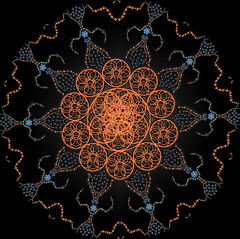
the flower of life Cargado originalmente por hinton.jennie
There are many symbols found within the Flower of Life's design, each believed to possess significant meaning.
Egypt - The Temple of Osiris in Abydos and at Mount Sinai.
Hungary - Magyarország - Carphatians.
Israel - Masada
China - The Forbidden City and various temples.
Japan - Various temples.
India - The Harimandir Sahib (Golden Temple), Hampi, and the temples at Ajanta.
Turkey - Various old Roman sites.
Spain
Austria
Italy - Italian art from the 13th century (Wolfram 2002, p. 43).
North Africa - Morocco
Middle East - Lebanon and various Islamic mosques.
North America - Mexico
Seed of Life
The "Seed of Life" is formed from seven circles being placed with sixfold symmetry, forming a pattern of circles and lenses, which acts as a basic component of the Flower of Life's design.
According to some[who?], the Seed of Life is a symbol of depicting the seven days of creation in which God created life; Genesis 2:2-3, Exodus 23:12, 31:16-17, Isaiah 56:6-8. The first day is believed to be the creation of the Vesica Piscis, then the creation of the Tripod of Life on the second day, followed by one sphere added for each subsequent day until all seven spheres construct the Seed of Life on the sixth day of Creation. The seventh day is the day of rest, known as the "Sabbath" or "Shabbat."
In the 13th century, a Cabalist group from France succeeded, through geometric interpretation, in dividing the entire Hebrew alphabet into an order using the Seed of Life. The resulting alphabet was remarkably similar to that of the Religious sage Rashi who wrote his commentaries on the Old Testament at that time in France.
Vesica piscis
The Vesica Piscis is formed from two intersecting circles of the same diameter, where the center of each circle is on the circumference of the opposite circle. Its design is one of the simplest forms of sacred geometry. It has been depicted around the world at sacred sites, most notably at the Chalice Well in Glastonbury, England, and has been the subject of mystical speculation at several periods of history. One of the earliest known occurrences of the Vesica Piscis, and perhaps first, was among the Pythagoreans, who considered it a holy figure.
According to some religious beliefs[who?], the Vesica Piscis represents the second stage in the creation of the Seed of Life, in that it was constructed by "the Creator" (or "God") through the creation of a second Spherical Octahedron joined with the first. It is said that the Creator's consciousness began inside the first sphere and journeyed outside the surface of that sphere to create the second. Purportedly in reference to this, the Old Testament refers to "the spirit of the Creator floating upon the face of the waters."
Continuing with these beliefs[who?], God is said to have created light through the creation of the second sphere (or Vesica Piscis). "Let there be light" is a relevant excerpt from the Old Testament. The pattern of the Vesica Piscis is said to be a geometric formula which represents the electromagnetic spectrum of light. For further information on how this can be done, see Drunvalo Melchizedek's book, The Ancient Secret of The Flower of Life.
Tree of Life
The symbol of the Tree of Life may be derived from the Flower of Life. The Tree of Life is a mystical concept, a metaphor for common descent, and a motif in various world theologies and philosophies. This mystical concept has historically been adopted by some Christians, Jews, Hermeticists, and pagans. Along with the Seed of Life it is believed to be part of the geometry that parallels the cycle of the fruit tree. This relationship is implied when these two forms are superimposed upon each other.
The Tree of Life is most widely recognized as a mystical concept within the Kabbalah, which is used to understand the nature of God and the manner in which He created the world ex nihilo (out of nothing). The Kabbalists developed this concept into a full model of reality, using the tree to depict a "map" of creation. The tree of life has been called the "cosmology" of the Kabbalah.
Some believe the Tree of Life of Kabbalah corresponds to the Tree of Life mentioned in Genesis 2:9.
http://en.wikipedia.org/wiki/Flower_of_Life

















No hay comentarios:
Publicar un comentario